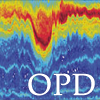
|
Harper Simmons Senior Principal Oceanographer hsimmons@apl.washington.edu |
Education
B.A. Physics, University of Alaska, 1995
M.S. Coastal Hydrology, University of Alaska, 1996
Ph.D. Physical Oceanography, Florida State University, 2000
|
Publications |
2000-present and while at APL-UW |
Characterization of mixing at the edge of a Kuroshio intrusion into the South China Sea: Analysis of thermal variance diffusivity measurements Sanchez-Rios, A., R.K. Shearman, C.M. Lee, H.L. Simmons, L. St. Laurent, A.J. Lucas, T. Ijichi, and S. Jan, "Characterization of mixing at the edge of a Kuroshio intrusion into the South China Sea: Analysis of thermal variance diffusivity measurements," J. Phys. Oceanogr., 54, 1121-1142, doi:10.1175/JPO-D-23-0007.1, 2024. |
More Info |
15 Jan 2024 |
|||||||
|
The Kuroshio occasionally carries warm and salty North Pacific Water into fresher waters of the South China Sea, forming a front with a complex temperature-salinity (T-S) structure to the west of the Luzon Strait. In this study, we examine the T-S interleavings formed by alternating layers of North Pacific water with South China Sea water in a front formed during the winter monsoon season of 2014. Using observations from a glider array following a free-floating wave-powered vertical profiling float to calculate the fine-scale parameters Turner angle, Tu, and Richardson number, Ri, we identified areas favorable to double diffusion convection and shear instability observed in a T-S interleaving. We evaluated the contribution of double diffusion convection and shear instabilities to the thermal variance diffusivity, X, using microstructure data and compared it with previous parameterization schemes based on fine-scale properties. We discover that turbulent mixing is not accurately parameterized when both Tu and Ri are within critical ranges (Tu > 60, Ri < 1/4). In particular, X associated with salt finger processes was an order of magnitude higher (6.7 x 10-7 K2 s-1) than in regions where only velocity shear was likely to drive mixing (8.7 x 10-8 K2 s-1). |
|||||||||
Formation and circulation of newly ventilated winter water in the western Beaufort Sea Lin, P.G., R.S. Pickart, T.J. Weingartner, H.L. Simmons, M. Itoh, and T. Kikuchi, "Formation and circulation of newly ventilated winter water in the western Beaufort Sea," Prog. Oceanogr., 216, doi:10.1016/j.pocean.2023.103068, 2023. |
More Info |
1 Aug 2023 |
|||||||
|
Newly ventilated winter water (NVWW) is a cold, salty, nutrient-rich water mass that is critical for supporting the ecosystem of the western Arctic Ocean. In this study, NVWW formation is documented using timeseries from an 8-mooring array deployed from 2008 to 2009 across the shelf and slope in the western Beaufort Sea near 150°W. The saltiest (densest) class of the winter water (salinity > 32.6), which is able to ventilate the cold halocline in the interior Canada Basin, was only observed on the inner shelf from December to May. The reasons for this are three-fold: (1) In mid- to late-fall the water on the outer shelf is largely influenced by fresher water in the vicinity of the shelfbreak, limiting the density of the winter product there; (2) during winter the variance in ice cover is significantly higher on the inner shelf than the outer shelf, and this enhanced presence of leads and polynyas results in more re-freezing and hence formation of saltier winter water; and (3) the cross-shelf velocities during the cold months (December–May) were negligible at the array site. To better understand the ultimate fate of the salty NVWW, the components of the western Beaufort Sea boundary current system were quantified using the array data plus additional mooring data to the west. It is argued that the salty NVWW can be fluxed off the shelf due to the convergence of the westward-flowing current on the shelf and the eastward-flowing outflow from Barrow Canyon. |
|||||||||
Boundary layer energetics of rapid wind and wave forced mixing events Skyllingstad, E.D., R.M. Samelson, H. Simmons, L. St. Laurent, S. Merrifield, T. Klenz, and L. Centuroni, "Boundary layer energetics of rapid wind and wave forced mixing events," J. Phys. Oceanogr., 53, 1887-1900, doi:10.1175/JPO-D-22-0150.1, 2023. |
More Info |
5 May 2023 |
|||||||
|
The observed development of deep mixed layers and the dependence of intense, deep-mixing events on wind and wave conditions are studied using an ocean LES model with and without an imposed Stokes-drift wave forcing. Model results are compared to glider measurements of the ocean vertical temperature, salinity and turbulence kinetic energy (TKE) dissipation rate structure collected in the Icelandic Basin. Observed wind stress reached 0.8 N m-2 with significant wave height of 4–6 m, while boundary layer depths reached 180 m. We find that wave forcing, via the commonly used Stokes drift vortex force parameterization, is crucial for accurate prediction of boundary layer depth as characterized by measured and predicted TKE dissipation rate profiles. Analysis of the boundary layer kinetic energy (KE) budget using a modified total Lagrangian-mean energy equation, derived for the wave averaged Boussinesq equations by requiring that the rotational inertial terms vanish identically as in the standard energy budget without Stokes forcing, suggests that wind work should be calculated using both the surface current and surface Stokes drift. A large percentage of total wind energy is transferred to model TKE via regular and Stokes drift shear production and dissipated. However, resonance by clockwise rotation of the winds can greatly enhance the generation of inertial current mean KE (MKE). Without resonance, TKE production is about 5 times greater than MKE generation, whereas with resonance this ratio decreases to roughly 2. The results have implications for the problem of estimating the global kinetic energy budget of the ocean. |
|||||||||






